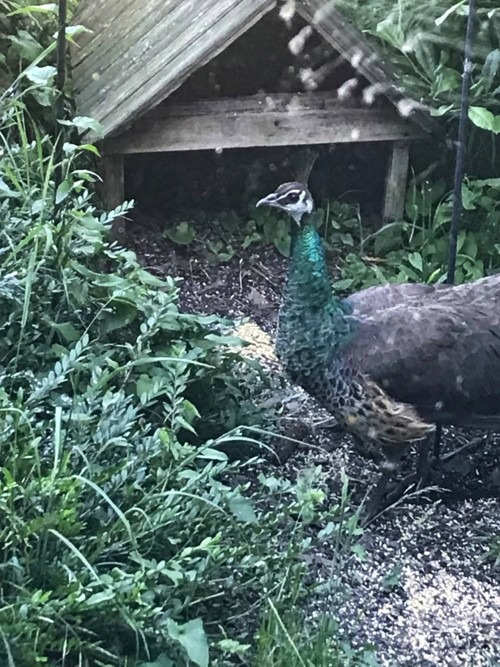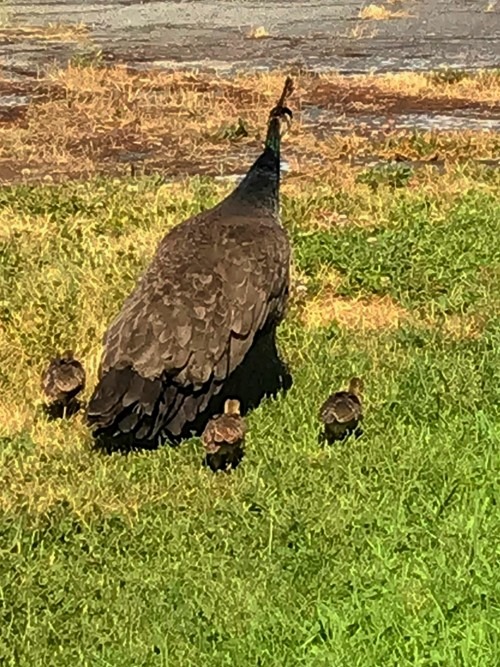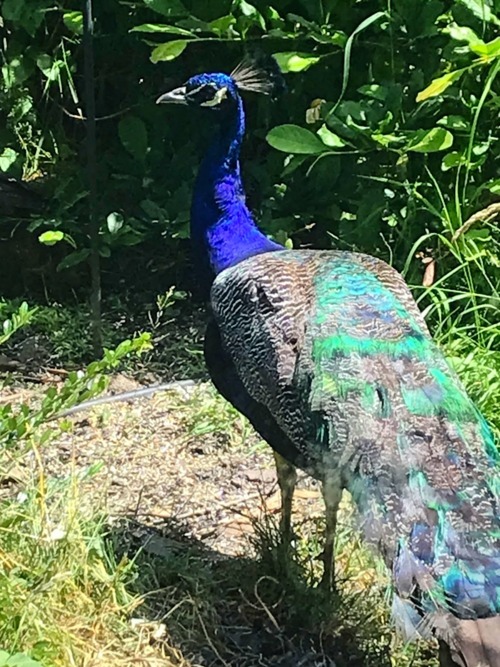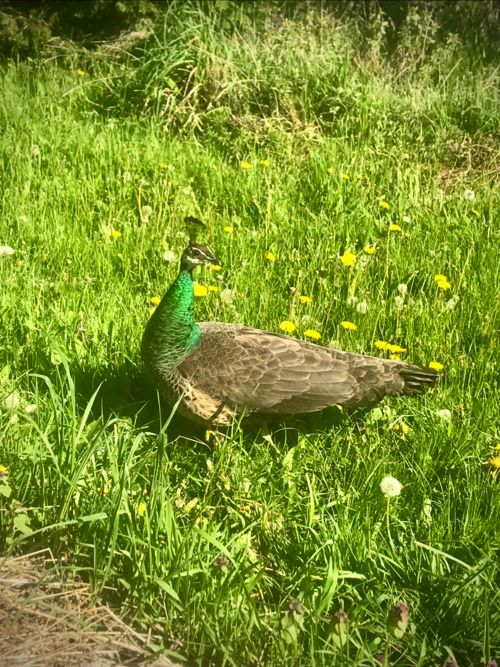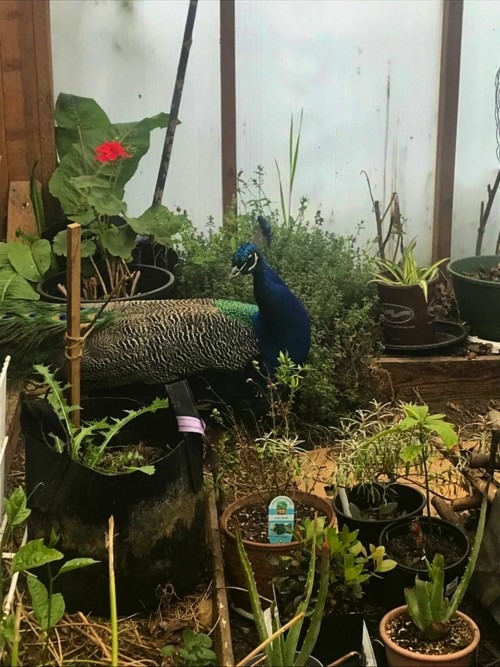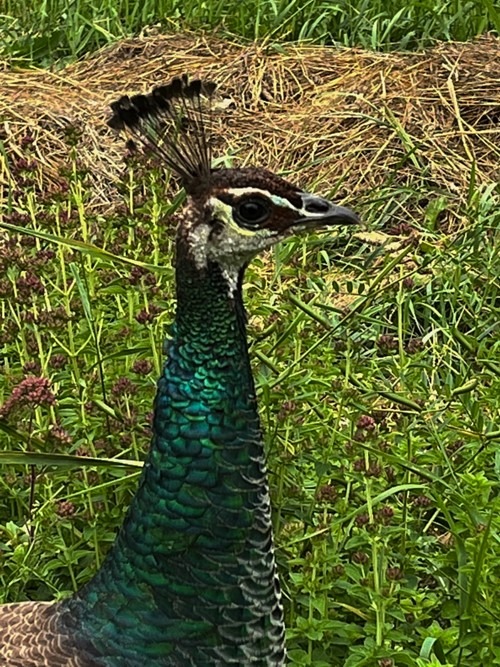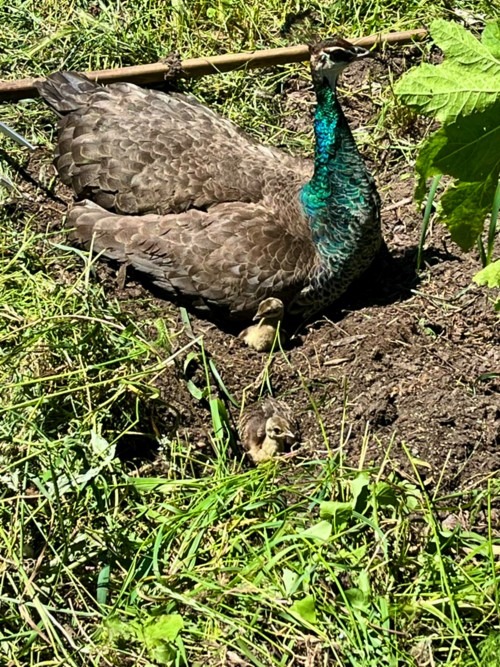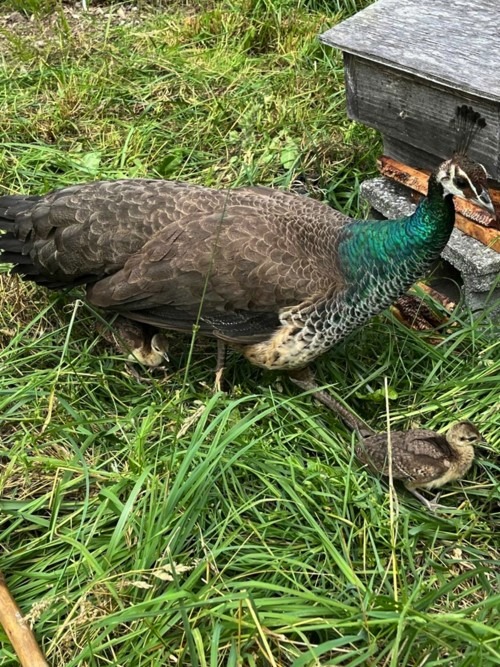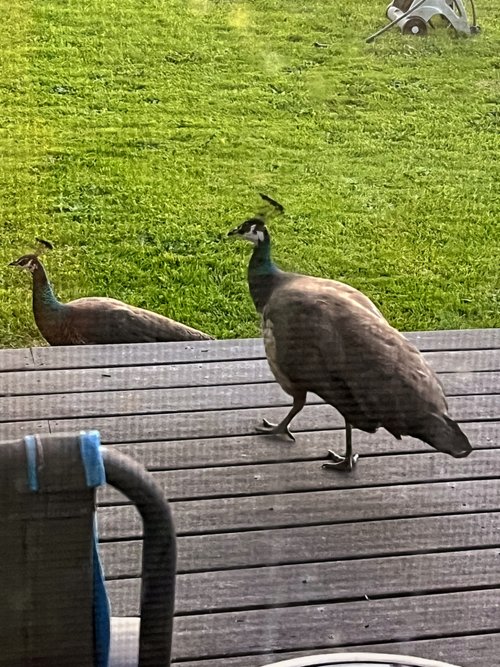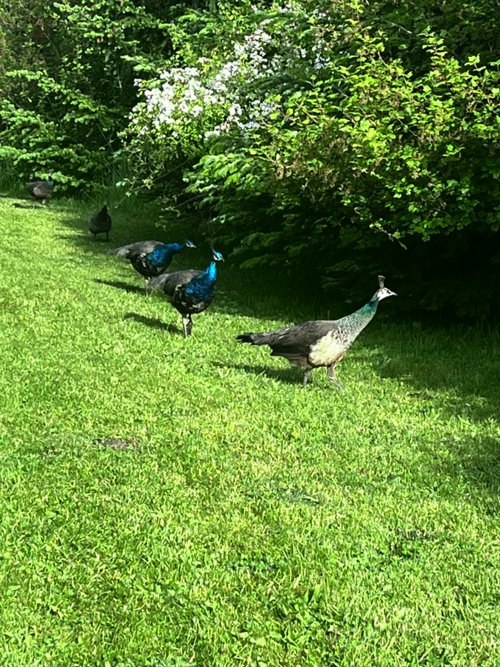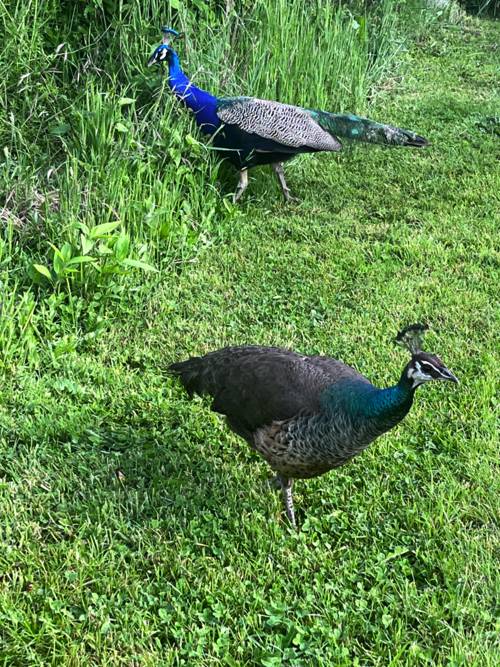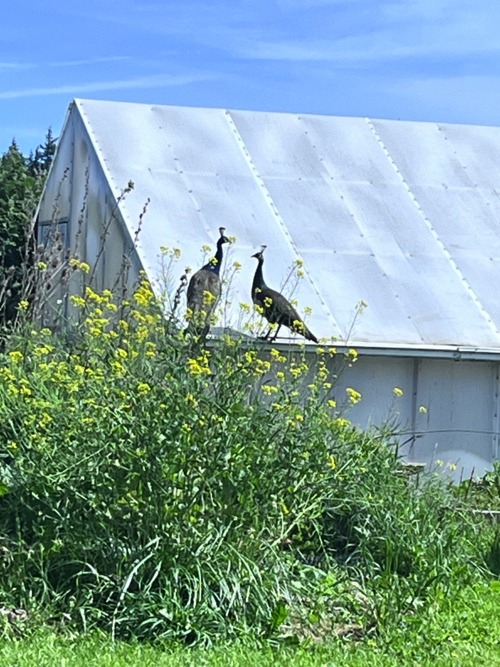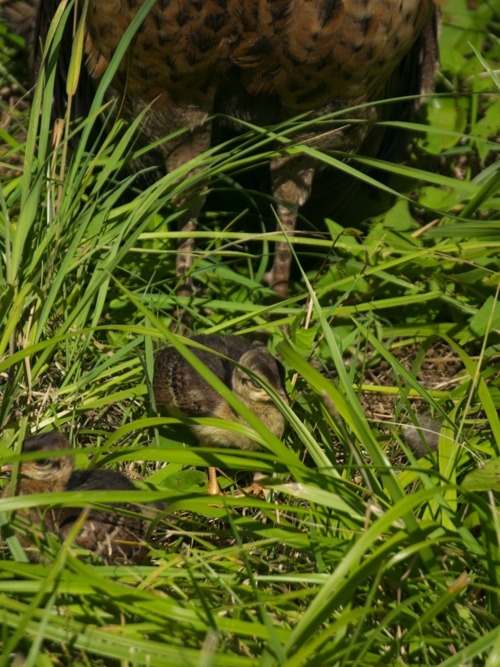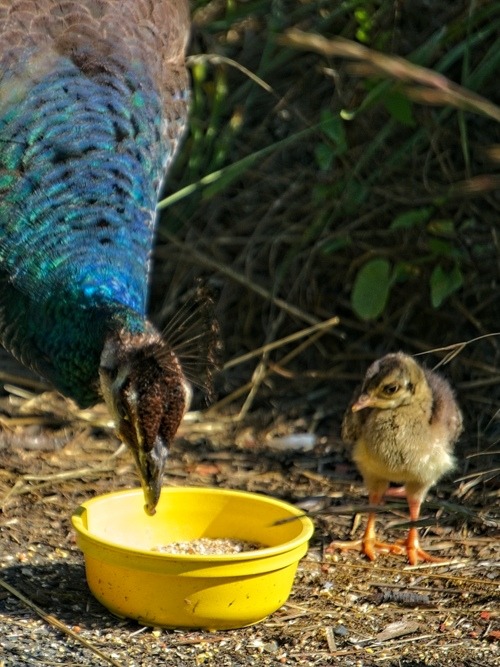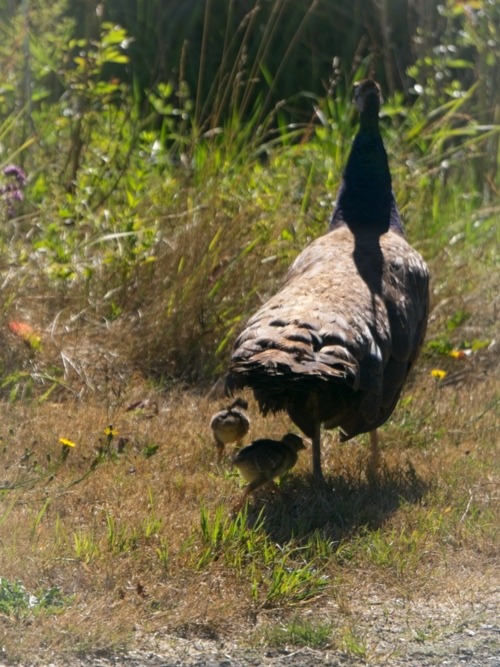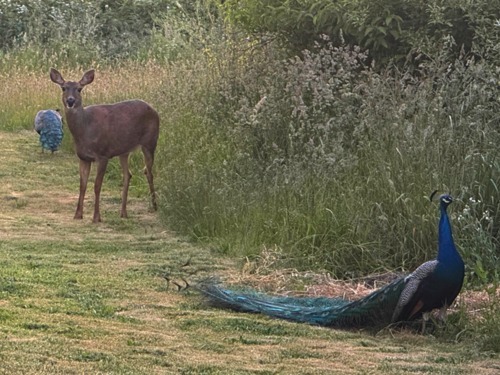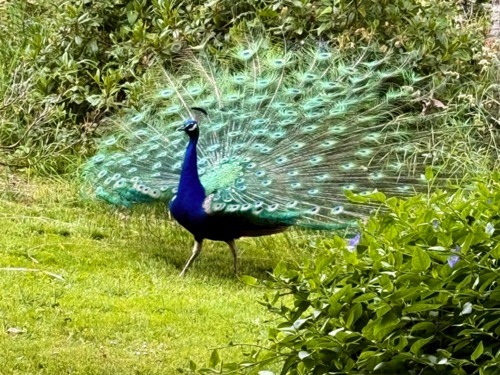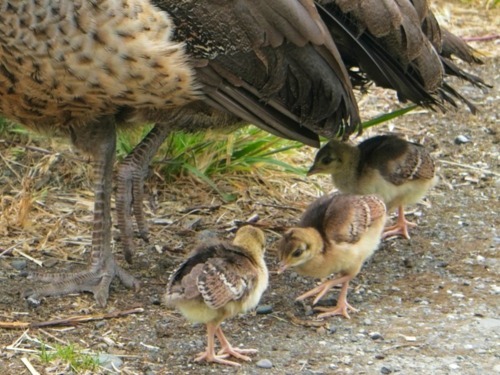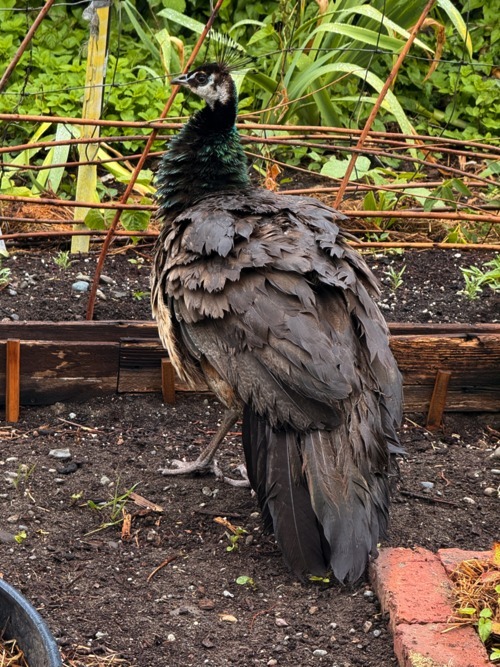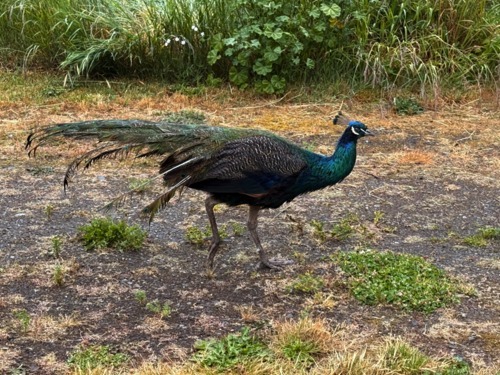The saga of being repeatedly invaded by peacocks (technically, peafowl) and how they changed our lives
Journal Notes, Text Messages, Questions, and Quandaries from 2018 to ….
2018: An Introduction
6/4/18: Text to my daughter: “WOW. You won’t believe this. A couple of peacocks just showed up in our backyard!”
They have undoubtedly come from the Game Farm a few miles away – semi-feral escapees with an adventurous spirit. My kind of birds!
I didn’t keep close track, but these occasional sitings continued for the next few years. Such a thrill! Peacocks! Go figure!
And, well, it makes total sense – if you create a bug-friendly environment, the wild things will come for dinner. We have been amazed at how we have so many more birds here now – from hummingbirds to bald eagles – and also snakes, frogs, raccoons, opossums, moles, deer, coyotes… it’s a busy place. We don’t have farm animals, but lots of others like to hang out here. So if peacocks are in the hood, why not?
2021: This year, I took notes and photos.
April 28: “Holy Moly! There is a peacock walking by our window!”
Brilliant turquoise blue and green. Shimmering iridescent in the sun. Absolutely magical!
He scouted out our property, flew to a high treetop branch, and called out to his brethren. The call pierces the air, shrill and clear, traveling for miles, “Coast is clear!” An acknowledging call returns from afar.
5/15/21: “Wow. There are four of them here now — two males and two females, pecking at bugs and leftover birdseed. They act like they own the place. They are very curious birds and so very large!”
Perhaps they recognize we are the only ones in the neighborhood without dogs. Plus, we have an entire jungle out back to hide in.
We clasp our hands together and feel like we are the chosen ones.
5/28/21: A peahen stands beneath the birdfeeder, taking her time picking up millet and other scattered seeds. All the little birds are flitting about nearby and saying “WTH?”
7/6/21: Peachicks! Mama peahen and 3 chicks are roosting in the corkscrew willow. The little ones have a hard time keeping up, but know safety is under their mother’s wings, even if high on a branch. They have to jump and flap those tiny wings really fast to make it to the lowest branch. It is not easy!
And in the early fall, they all left. Thank goodness! I don’t know how we could provide shelter for them for over the winter.
2022: Life Lessons
5/8/22: “Gertrude” the peahen is back. Hmmm. Is this a good thing? I’m not sure about the name, Gertrude. That was my grandmother’s name. I prefer Big Mama. Should we be naming them?
6/30/22: I have been trying to get some things planted this year and it is a lost cause. Slugs, deer, and now peacocks …
They get into everything. Every new bed turns into their personal dustbath area. One long-tailed guy was even bold enough to check out the greenhouse.
Question: Is curiosity a sign of intelligence?
~*~
July: We have peachicks! (I call them Chicklets). Mama peahen is showing them all the best places to go, which just happens to be where I am gardening.
I cleared an area for some transplants, went to the house just for a moment, and when I returned, there was mama peacock and her two chicks having a party. Turned around, and there was another peahen with four chicks! They followed me and literally ate the beans right after I pushed them in the ground.
Ah, but the chicks are fuzzy, gangly, and absolutely adorable. The peahens take them in difficult places to follow: into the raspberries, over rolled hoses, through thickets of underbrush. Sometimes they get tangled up and confused and “cheep cheep cheep” loudly. The mama comes back to get them. Each hen knows her own chicks.
~*~
I am definitely seeing some pros and cons to these beautiful but destructive birds. There is a good reason why we don’t raise turkeys. And unlike turkeys, these birds can fly over any kind of enclosure we might build – and are likely to escape any kind of coop – which we are not going to build for a semi-feral bird that is not really ours. Besides, they prefer to roost in trees some 20 or more feet high, and the hens are skilled at hiding in the underbrush, wherever it is they are nesting.
~*~
7/19/22: Ok. I am trying a compromise. I made them a sandbox. If you can’t beat them, join them. Maybe they will quit rolling around in my newly planted garden beds.
7/20/22: Surprise surprise. The peacocks do not like my sandbox. They walked through it because they were curious, but they did not linger in the warm sand.
Perhaps the sandbox is too Sandy? Not big enough? They think they need dirt. Dirt is found wherever I have recently cleared a place to plant something, because everything else is weeds around here. I have been blocking off newly planted areas with whatever I can find: pieces of wire fencing, bamboo, willow sticks, rakes and shovels — just about anything that will keep them out without smashing the plant. I call it the “ghetto-chic” look.
Today I found mother peahen in a small pit she had dug next to where I had recently planted a quince tree. It was a rather fragile sapling I had grown from a cutting and had been babying in the greenhouse for the past two years. She had her back end smashed up against the little wannabe-a tree and was fluffing both wings out in the dirt. Her chicks managed to squiggle out from beneath her among all the dust. All of them enjoyed rolling around in it.
Fortunately, the quince is still standing. I will give it a good watering when they leave and reapply mulch–not that it will stay there long.
Hmm. They also like to roll around in mole hills, which is very fine dirt and makes its own little pit, which appears quite snuggly. It kind of makes me want to try it.
These birds are quite the challenge. I am thinking a lot about how to simplify my gardening. This is not it.
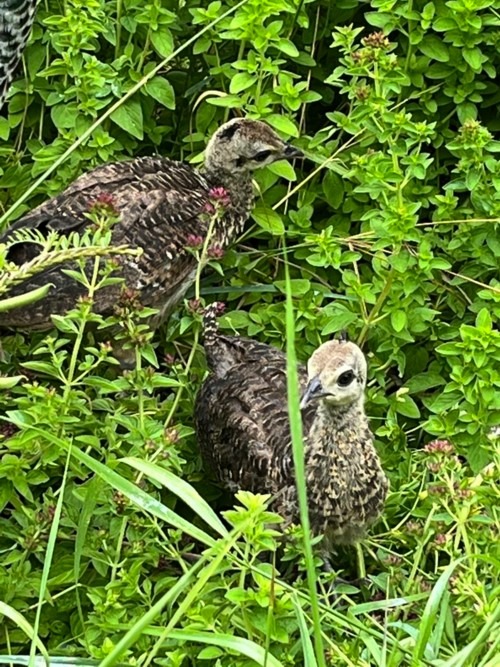
7/22/22: Chicks are getting bigger! They are growing their grownup feathers and looking more like peafowl! Aren’t they beautiful!
It’s a good thing those babies are so darn cute! They are getting real wings now and attempting to fly — and they have little topknot feathers coming out of the top of their heads about 1/4 inch, so it looks kind of funny.
If I clear out a path, they are the first to follow it. They even follow me about, sampling things here and there. They seem to particularly like various herbs, for instance, lemon balm and oregano. The mother will often snip a large leaf off of something and drop it down for the little ones. Sometimes the chicks will both step up at the same time and each grab an end until it breaks in two.
It’s really quite endearing.
This morning, as I stood here watering, the mother hen was curious about the sound of water and brought her little ones right up to me to check it out, sampling a diversity of herbs along the way. She stopped at the red currant bush and proceeded to pick off every single red currant. She did not share. The little ones hopped up to the ones on the lower branches.
At least now I know where they all went.
~*~
Late September: The air is getting colder, the days shorter, and the geese are gathering in the fields. The chicks are now able to follow their mother into the trees. She takes them higher and higher, hopping up to one branch and then another. Eventually, they all settle on a branch together, the chicks still trying to all fit under her wings.
In this photo, she is above our 2-story barn. I used a 200-mm lens to capture this.
[This does not look like a safe place to stand.]
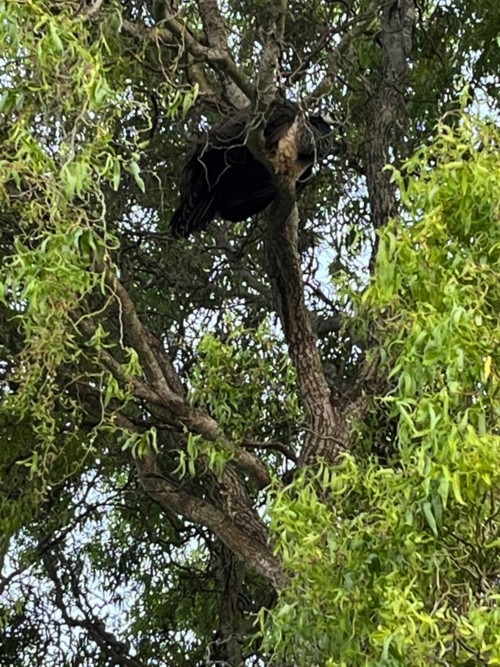
In the early morning, just after they hopped down to start the morning foraging, an eagle swooped down and snatched a chick. Perhaps it was a hawk. We did not actually see it – but we heard the mother’s frantic calls. All the birds are upset. Me, too.
A few days later, they all left. We hope they find a safe place for the winter. We think the neighbors down by the creek will be a good home. They have several tall outbuildings.
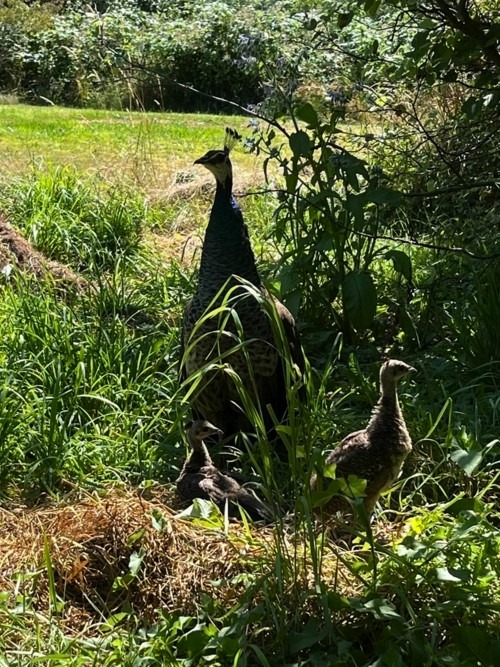
Things sure are suddenly quiet around here.
2023: Pros, Cons, and Grand Spectacles
5/23/23: The peacocks have returned! Yes, they are beautiful – but I admit, I have mixed feelings….
5/31/23: Text message to daughter: “About 47 degrees & windy here this morning. Stepped outside with my coffee and was greeted by 3 peacocks. One of the hens follows me around sometimes and has taught me to bring her corn chip treats. She follows Jeff when he mows the lawn — catches the bugs that jump out of the way.”
They are like overgrown chickens with a splash of color. Bulky. They eat everything. My currants and blueberries are a thing of the past. My vegetable sprouts–gone.
In fact, everywhere I try to make a new garden bed, they come along and roll in it, because like chickens, they enjoy a good dust bath.
My garden is spread out in areas over 2 acres and now I have to build fences around anything I want to grow. I am seeing the advantage of having a traditional vegetable garden in a fenced enclosure, but that would be expensive and a lot of work at this point.
Instead, I have made quick attempts to hoop willow branches around my recent transplants. The peafowl ignore them and step right through them. One peahen even had the gall to roll around in a flower pot. It was a big pot, but still. I had just put geraniums in it.
Oh – and did I mention – these bulbous creatures also fly!
I am already so done with these guys.
~*~
7/6/23: A new guy in town. He’s kind of a show-off. How does he even drag this beautiful tail around?
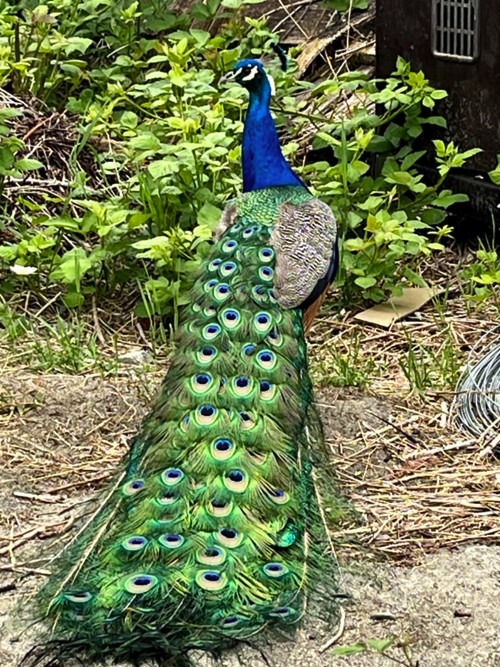
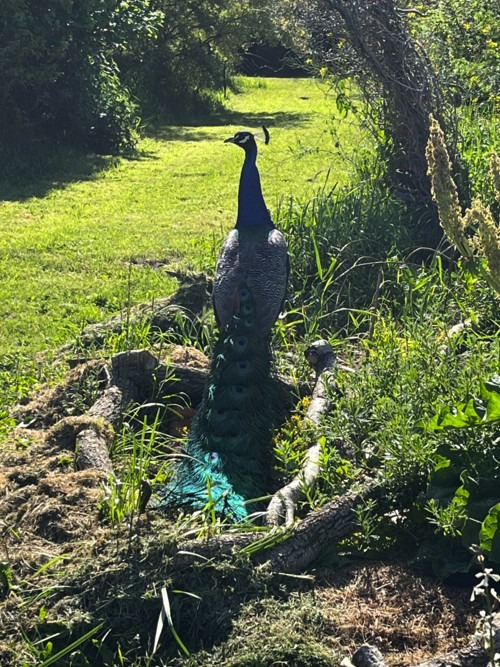
7/8/23: Look who greeted us when we came home from the Farmer’s Market. I think there is some partying going on in our absence! These 2 peacocks kind of took over our place – and then they invited their friends.
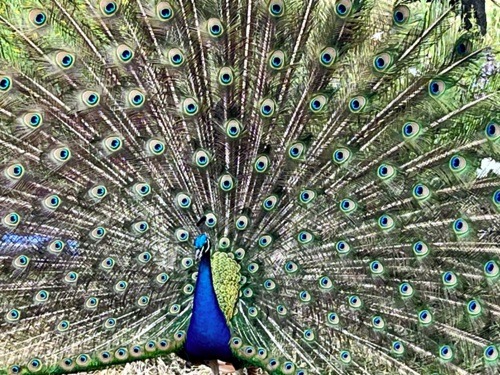
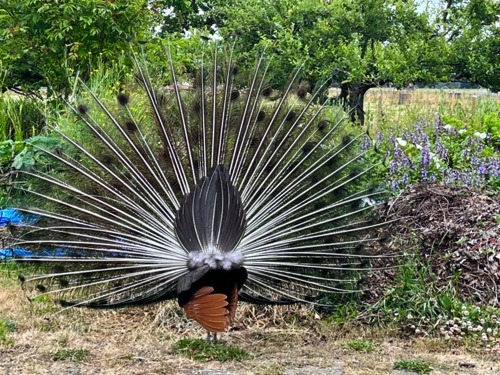
According to a study by Haverford College physicist, Suzanne Amador Kane, peacocks shake their tails at very high speeds—about 26 times a second. This creates a stunning visual illusion in which their eyespots seem to hover against a shimmering background. It also creates a rattling noise, and a wave of pressure that could conceivably vibrate the crest of a watching female.
The study found that the crest on a peahen is much more than a fancy accessory -- it is also a sensor. Her feathers are tuned to vibrate at the exact same frequencies at which a displaying peacock rattles his tail. When a male shows off his trademark fan, the female he’s courting doesn’t just see him -- she also feels him -- in her head.
~*~
Oh – And now they have five babies:
Peahen with 5 chicks. It’s a lot to keep track of, but she does a good job.
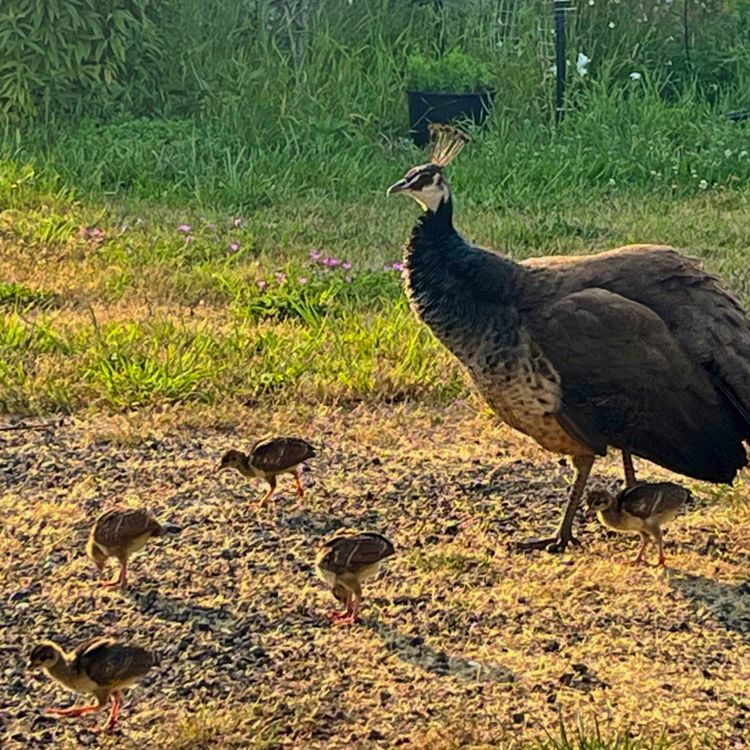
And another season comes to a close.
2024: Compromises and Mutual Understandings
I can’t believe it. The peacocks are back. They are on our porch. Their heads pop up in the grass and they watch our every move. They come up to us and cock their heads in expectation of food, which we readily supply. They hatch their young, teach them how to survive, and take care of one another. We are mesmerized by their incredible natural beauty and drawn to their quirky personalities. They gather in groups and map out the maze of hidden corridors I have created among the hazels, firs, and cedars. And sure, once again, they have turned every planting area into their personal dust bath spa. If I cover the bare earth with mulch, they simply scratch it out of the way. They hop up onto the roof of the house, the barn, and even the greenhouse, And they eat the fruit I have worked hard to grow. It is a problem. One that I have obviously created.
We are going to have to learn how to live together.
5/7/24: At first, they peek up out of the grass to see if it might be ok to be here.
I mean, they are an invasive species! They are pretty but destructive, and yes, Very Noisy. They hop up on the roof and wail to one another at 4:30 in the morning. They eat the bugs my other little bird friends need to feed their chicks. They eat all my blueberries and currants and anything else they can hop up and get. They also eat every seedling that I try to plant and, did I fail to mention, they make dust baths in all my newly dug beds.
I think they just might taste like chicken.
But the thing is, they don’t know they are an invasive species. They are just trying to find a safe place to raise their young. This will be the seventh (!) year they have returned here, so they know us by now. They know we have a jungle in which they can hide. No cats or dogs.
Sigh… I guess I will let them stay. (I admit, I rather like them).
5/12/24: We have been invaded. There are at least seven, maybe more. They follow Jeff around when he mows the lawn. I think they remember him. He kind of likes them. I think the feeling is mutual. Uh oh.
I follow them to better understand their habits. They seem to do most of their foraging in the morning, disappear midday, and then party at twilight. They call to one another at 11 pm from the cherry and fir trees outside our bedroom window. It is shrill, piercingly loud, and sounds a whole lot like a strangling cat. Earplugs don’t help much. At 4:13 a.m., they are calling to one another again. We are not ready to be awake.
I am wondering – do they help me with pest control? Or are they just eating the bugs that would otherwise nourish all the little birds I feed through the winter and who are now nesting and raising young? It must take a lot of insects to sustain such a huge body. I hope they do not eat snakes and frogs. Perhaps I should feed them more grain, since they are so determined to stay here.
I visit our local feed store and find a product made for wild fowl: Game Bird Crumbles. It has 30% protein, much higher than that in plain ol’ chicken scratch (8-10%). After all, aren’t these sort of like fancy pheasants or chunky chukars? I debate. [I must be nuts for buying them this. It’s not cheap.]
5/19/24: My new friend. We have come to an understanding. She knows I will help her.
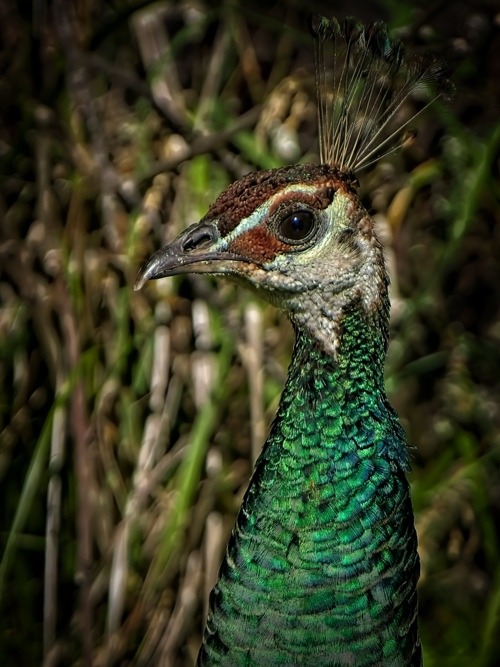
I am joking about that last part.
~*~
6/21/24: Summer Solstice
We are welcomed today by a new clutch of peachicks. Three fluffy, fuzzy, chirping blobs on skinny twig legs. The peahen is ravenously hungry and welcomes my humble grain offering in celebration. She holds her beak to the ground to show the chicklets the food. They get it.
They also get the new alpine strawberries I am growing behind a willow-fence enclosure. She points to the holes to jump through, and one by one, in they go. The alpine strawberries are tiny but especially sweet, as I remember.
The peahen has a call more like a braying donkey. With a coarse “Hee-haw,” she announces her presence. I am pretty sure she is calling me – so of course, I bring her some grain. She prefers the chicken scratch and birdseed to the expensive wild bird kibbles I bought for her. Whatever. I put down a bit of everything.
~*~
A gang of peacocks patrolled the hood this morning – 12 of them. True. A full dozen. It must be last year’s clutches – and now they are swaggering young adults, finding their voices–which are ear-piercingly loud. They are skittish when I approach. Not quite as bold as they’d like to think.
Sidenote: It is illegal to kill peafowl in India, where they are revered as the national bird. Peafowl are linked to the goddess of wealth and prosperity, thought to bring good luck, and symbolize the divine beauty of creation. However, the birds have one of the fastest growing populations across the land and now cause immense damage to crops, resulting in farm losses and higher produce prices, especially rice and leafy vegetables. In fact, in some regions, the peafowl have been ranking second only to monkeys and wild boars in the state’s list of agricultural pests.
I will take peacocks over monkeys and wild boars any day.
Still, I have to wonder, are we blessed or cursed?
My daughter is sending me recipes for roasted peacock from a 1920’s cookbook.
All you have to do is “Skin the peacock, keeping neck and head intact…Lard the carcass with bacon, stuff with turkey forcemeat, fix it on a spit, and roast it two hours or more before a brisk fire, basting continually with white wine.”
Oh – but the best part is the final paragraph:
“In France, it is almost a mythological dish around which the following legendary recipe has been built up by ambitious gastronomes:
Pluck and clean the biggest peacock you can find and save the giblets for the gravy. Next prepare the biggest Tom turkey you can get, and stuff the peacock with it. Stuff the turkey with a fine fat Strassburg goose, the goose with a capon, the capon with a juicy pheasant, the pheasant with a canvasback duck, the duck with a partridge, the partridge with a quail, the quail with a squab, the squab with a snipe, the snipe with an ortolan, the ortolan with a fig-pecker, and finally fill the fig-pecker’s little tummy with one small oyster.” (Posted on Reddit by someone named “Intestinal-Bookworms.”)
I got hung up right at the beginning on how to stuff a turkey into a peacock, but they must have been referring to the smaller, wild turkeys of the time, not the hormone-enhanced versions we get today. Regardless of the logistics, I try to be whole food, plant-based and have no desire to eat any of these birds. Ever. Especially that little fig-pecker.
Instead, I am contemplating investing in a series of water sprinklers with motion sensors. And I might buy a bottle of good wine, too…I prefer red. No basting or stuffing needed.
(In the photo, she is giving us the side-eye…”Don’t even THINK about it!”)
No worries!
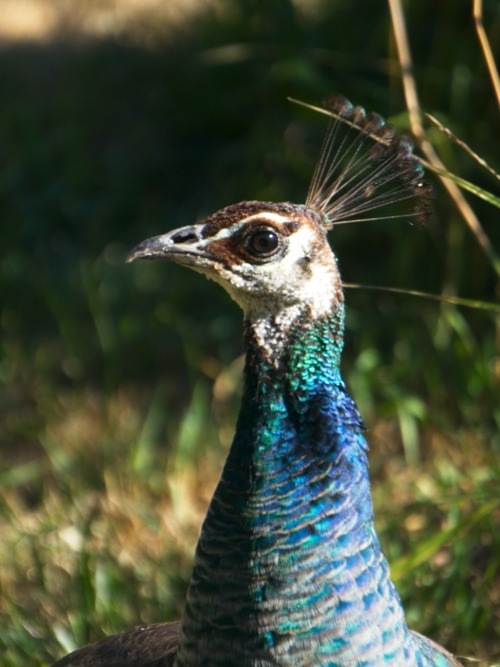
~*~
Summer’s End: The deer and the peacocks managed to eat most of the raspberries and anything I tried to plant. The peacocks have now gone wherever they go for winter shelter. They seem to know when the geese fly in arrows overhead, calling to their wilder instincts, it’s time for them to leave, too.
And so we have concluded another year. We have come to a compromise. I give them a safe place to raise their young and adjust my gardening to mostly shrubs, willows, and herbs; they give me – well, I’m not sure – the grace of their presence, I suppose.
I just read that peacocks often live 20 years in the wild – and 30-40 years in captivity. Uh oh.
2025: Highs and Lows
4/18/25: Well, what d’ya know! They are b-a-a-a-ck! Peacocks! The first scout showed up and once again announced to his friends from the top of the cherry tree outside our bedroom window, “Coast is clear!” He is a bit wary of us. Understandably. I’d be wary of us, too. But we admit, we are glad to see them.
5/5/25: Well, look who’s here: Big Mama. I think she remembers me. She came right up within a few feet of me, so of course, I went and got her some birdseed while she got busy rearranging my mulch.
5/12/25: And then there’s this big guy who thinks he owns the place. Actually, there are two key males; an older, dominant one with a spectacular tail and a smaller, younger one, who likes to follow around a young female.
5/13/25: I admit a certain fondness for Big Mama. Today was a beautiful spring day with a slight breeze, and I found her atop the compost pile out back, preening her feathers in the sunshine, surrounded by blooming wild mustards. I was moved to play her a tune on my chromatic harmonica: “What a Beautiful World,” made famous by Louis Armstrong and written by Bob Thiele and George David Weiss. I admit, holding the phone while playing the harmonica was a bit of a challenge – and it was not a tune I had practiced, but easy enough to pick out, and considering my audience, I did not think she would mind if it was a little rough. In fact, I thought she found it rather interesting – and even liked it.
5/28/25: When we came home last night, the big male was on top of the roof of the house like some kind of exotic weather vane.

~*~
6/7/25: Oh no. I just made a terrible mistake. I was trying to make sure the water lines were all running. I have installed a rather complex network of drip systems throughout most of the garden areas, but it takes time to make sure they are all running before the summer heat sets in. Sometimes there are breaks in the connections, lines need to be flushed, drippers get clogged and need to be replaced, etc. The grass, bindweed, blackberry vines, thistles, and other plants and mulch can make the lines difficult to find. In the process of trying to find them, I started pulling out thistles – and one led to another and another, until I had quite a pile of them. They can be so invasive.
It wasn’t until I almost stepped on her that I saw between an alder and a tangle of weeds, right at the abrupt drop-off to the road, the slightest hint of blue. And there, flattened out, disappearing into the ground, was my friend, Big Mama peahen.
I gasped. “Why, hello, Mama,” I said softly.
She knows my voice. Still, she did not move.
I am an idiot. I realized what I had done. I had inadvertently removed the thistle forest that had served as a cover for her nest, exposing her to any number of creatures in the night who would love to have a tasty egg for supper. Basically, I had cleared a direct pathway for any predator – raccoon, raven, opossum – to get to her nest.
I felt terrible.
Plus, I am pretty sure the water line runs right under her – so if I turn it on, everything will get soaked. And who would think of nesting in such a place, anyway – right by the drop off to the road, with traffic zipping by throughout the day? Maybe it was ideal because it was so unlikely?
I hauled my two large piles of weeds to where I had just cleared. They made a wall of sorts for now, but I knew they would quickly shrink in size.
The nest cannot be moved. It’s either stay and protect – or abandon. If she tries to start over, there might not be time for new eggs to incubate and chicks to grow to a size that can roost in trees and travel long distances before the cold weather sets in. She chose to stay and protect.
6/8/25: Afternoon – The two resident male peacocks seem determined to go over by Big Mama peahen’s nest. I stand and watch, unsure whether they are protecting or harassing her. Eventually I walk over there to encourage them to leave her alone, but after I leave, they return. They obviously know she is there. They are not pecking at the leftovers under the nearby feeder.
About 9 pm, I notice the two male peacocks and two deer in the backyard. It is close to sunset, and all seem to be getting along just fine. On closer look, though, I noticed the peacocks are feeling a bit anxious. This is THEIR backyard – their territory – and they are willing to say so. The deer, of course, are just passing through, like they always do. They know it is a good place to snack on a smorgasbord of greens and grains and where they can find fresh water.
The smaller male peacock felt a need to demonstrate he can be aggressive and marched toward the younger deer, flapping his large wings. The deer was a bit taken aback by this display and immediately retreated. The larger male, not to be outdone, lifted his long tail feathers and fanned them out wide, turning to the left and right while shaking them. The deer got the message and immediately left.
Meanwhile, the peahen, hidden in the shrubbery nearby, never moved.
9:45 pm: the peacocks are loudly calling to one another. What are they saying?
They are changing my perception. I no longer see the raccoons and opossums as rather cute mammals that visit our yard. Instead, they are ruthless predators. They are hungry. If an easy meal is available, they will take it – even fight for it. The night brings a whole different set of challenges.
It’s all about food.
And I just left my peahen friend wide open to killers of the night.
~*~
6/10/25: Four eggs confirmed in peacock nest. She comes out for food and water. I quickly run and get her some. She has me trained.
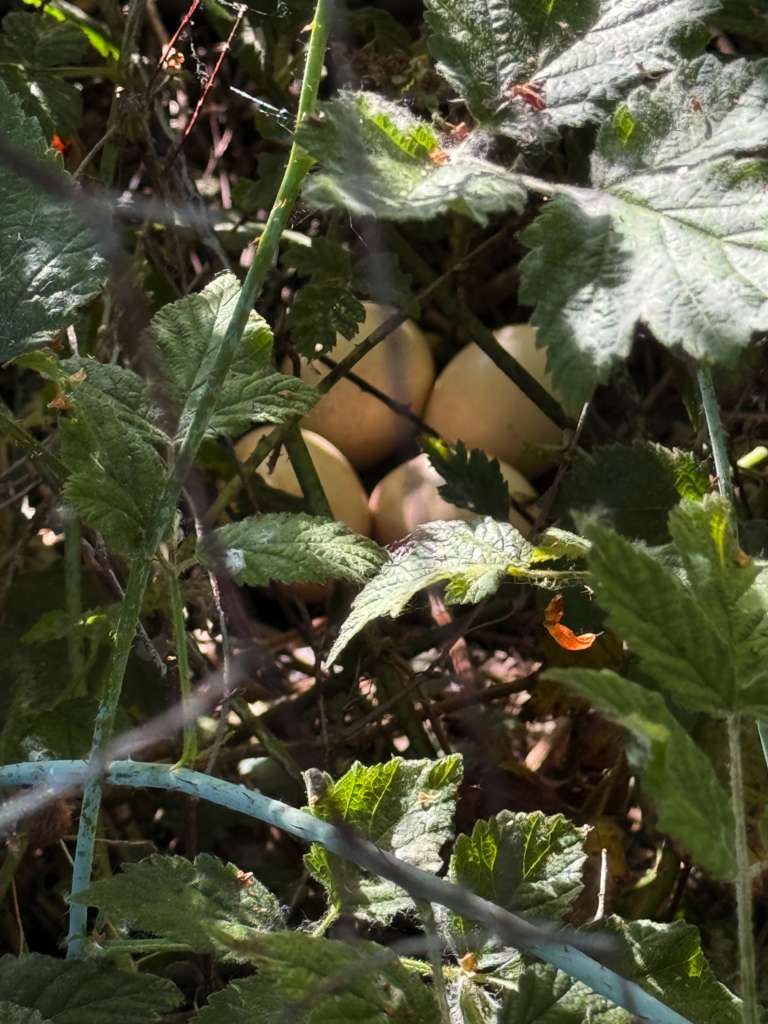
6/18/25: Chicks are hatched! Three out of four. I am not sure what day they hatched exactly, and although tempted to see if I could incubate the 4th egg, I have no idea how long it has been in the cold. I have to trust that mama peahen knows what is best.
We are flattered that they feel comfortable enough with us to introduce them. I take lots of photos and send out birth announcements to all my friends and relatives. The babies are adorable.
And my question - are peafowl chicks precocial? The answer is yes! They hatch and are ready to go! While some baby birds are born naked, blind, and totally dependent on parental help, peafowl chicks are born with feathers and can start foraging on their own right away. Their early tan feathers help camouflage them with the ground. After about a month, they grow stronger feathers that allow them to fly into trees to roost where it is safer. Mother peahens will watch over, protect, and teach their chicks for at least 6 months. By then, they will be able to better survive on their own.
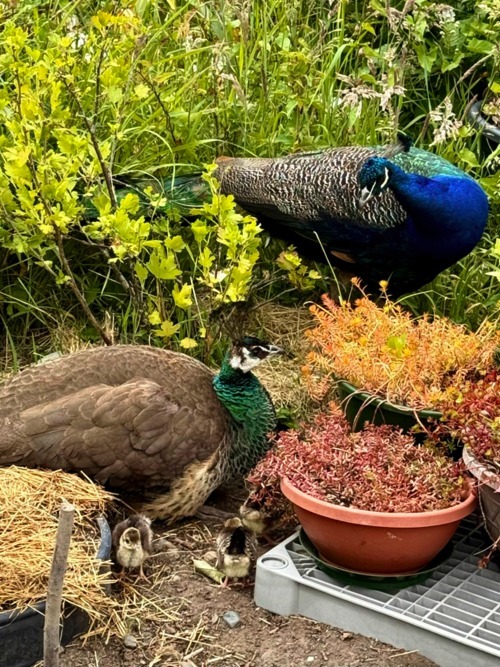
6/20/25: Summer Solstice – and on a day we would normally be celebrating, we are grieving. Something got all three of the peacock babies in the night or early this morning. We had a good rain, which we needed – and I was joking about how bedraggled the young male looked this morning. You would think he’d have sense to get out of the rain! But then I noticed there were no chicks with Big Mama. She was walking back and forth in the driveway and would occasionally call out to them. No high cheeping in response.
She kept going back into the orchard – and there I found a whole bunch of large black wing feathers. She and the young peacock must have put up a good fight to save them, but there is no sign of them at all this morning. She sits in the grass – and in the photo, if I look closely, I can see her nictitating membrane over her eye. It is like a third eyelid — a translucent, opaque membrane that moves horizontally across the eye. I might be anthropomorphizing by thinking she might be crying, but I don’t think so. I squat down in the grass not far away, and we shared some time together. I think she knew I knew and shared her sorrow.
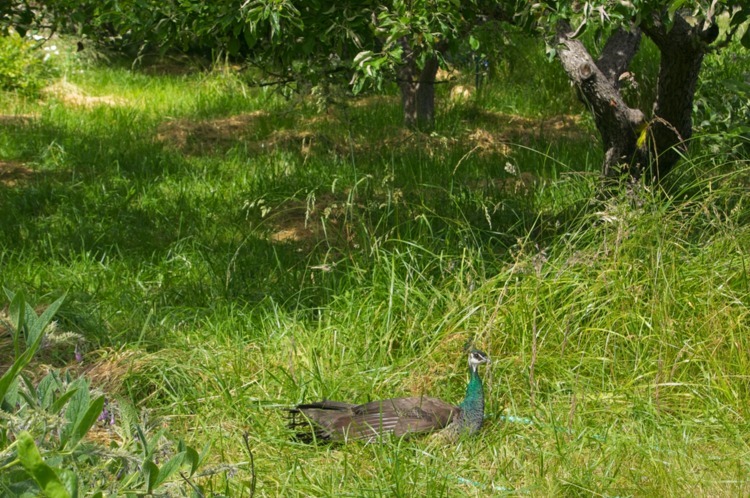
~*~,
What got them? We will never know. The neighbors’ dogs are all well-behaved. They would not do this. A hawk would only pick off one at a time. Raccoons can be pretty vicious – a definite possibility. Weasel?
I strongly suspect coyote. Sometimes I hear them at night, but usually in the distance. Our neighbor found scat in his field. So I suppose another scenario might have been that a coyote almost caught the young male, who managed to wriggle away with the loss of quite a few feathers. In a panic, everyone would have flown to the trees, but the wee ones were too young to fly. Not much of a morsel for the coyote, but better than nothing. The chaos was muffled in the night by the rain. We did not hear a thing.

And How to Move Forward
Every year, the majority of the peachicks have made it to where they could travel with the flock to the winter homestead. But to make it only a few days??? It is devastating. Not sure what I could have done to prevent it.
It’s a reality check. Here I have been trying to build this incredible paradise for animals … and apparently, our place is not as safe as I had hoped. It attracts wildlife, true – and that includes predators. This is the way nature works.
Mortality rates with peachicks are known to be high (it is estimated only 2 out of 6 make it to maturity), and the young on the ground are so very vulnerable. I now better understand why the peahen is in such a hurry to get her chicks up in the trees at night. The low branches in the orchard are good ones to learn on.
It’s not that nature is cruel. It just is what it is. Everything has to eat. The birds have learned to do their best and move forward.
6/29/25: The younger cock and hen are still around from time to time, as is the older peacock with the spectacular tail. I have not seen Big Mama peahen in several days, though. I don’t know whether she’s gone into hiding – moved on – or been eaten. If she were nesting nearby, she would come out now and then for food and water – and she would call for me – so…
My earlier thoughts come back to me: “…it makes total sense – if you create a bug-friendly environment, the wild things will come for dinner,” all up and down the food chain.
The peacocks have added so much razzle-dazzle to our lives. Oh, I suppose I can go back to being a regular gardener again; I might even harvest a few currants, raspberries, and blueberries…
…but we admit, we deeply miss the antics of these exotic, semi-feral fowl.
~ * ~
Some references:
Amador Kane, Suzanne, D Van Beveren, and R Dakin. November 28, 2018. “Biomechanics of the peafowl’s crest reveals frequencies tuned to social displays.” PLOS One.
Senaratna D*, Lingesh S and Atapattu NSBM. 2019. “Foraging Behaviour based Management Strategy to Minimize Crop Damage Caused by Indian Pea Fowl (Pavo cristatus).” Journal of Ethology & Animal Science, May 24, 2019.
SoIB (2023). State of India’s Birds, 2023: Range, trends, and conservation status. Pp. 119. The SoIB Partnership. doi:10.5281/zenodo.11124590.
Yarlagadda, Kavitha. March 23, 2024. “Who let the birds out? Across India, the country’s revered peafowl go head to head with farmers over crops.” Asia Democracy Chronicles.
Yong, Ed. 2018. “A Courting Peacock Can Shake its Partner’s Head from Afar.” The Atlantic. December 21, 2018. (subscription required)
